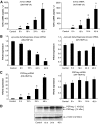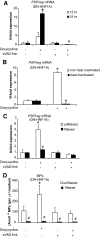INS-1 cells undergoing caspase-dependent apoptosis enhance the regenerative capacity of neighboring cells
- PMID: 20682686
- PMCID: PMC2963538
- DOI: 10.2337/db09-1478
INS-1 cells undergoing caspase-dependent apoptosis enhance the regenerative capacity of neighboring cells
Abstract
Objective: In diabetes, β-cell mass is not static but in a constant process of cell death and renewal. Inactivating mutations in transcription factor 1 (tcf-1)/hepatocyte nuclear factor1a (hnf1a) result in decreased β-cell mass and HNF1A-maturity onset diabetes of the young (HNF1A-MODY). Here, we investigated the effect of a dominant-negative HNF1A mutant (DN-HNF1A) induced apoptosis on the regenerative capacity of INS-1 cells.
Research design and methods: DN-HNF1A was expressed in INS-1 cells using a reverse tetracycline-dependent transactivator system. Gene(s)/protein(s) involved in β-cell regeneration were investigated by real-time quantitative RT-PCR, Western blotting, and immunohistochemistry. Pancreatic stone protein/regenerating protein (PSP/reg) serum levels in human subjects were detected by enzyme-linked immunosorbent assay.
Results: We detected a prominent induction of PSP/reg at the gene and protein level during DN-HNF1A-induced apoptosis. Elevated PSP/reg levels were also detected in islets of transgenic HNF1A-MODY mice and in the serum of HNF1A-MODY patients. The induction of PSP/reg was glucose dependent and mediated by caspase activation during apoptosis. Interestingly, the supernatant from DN-HNF1A-expressing cells, but not DN-HNF1A-expressing cells treated with zVAD.fmk, was sufficient to induce PSP/reg gene expression and increase cell proliferation in naïve, untreated INS-1 cells. Further experiments demonstrated that annexin-V-positive microparticles originating from apoptosing INS-1 cells mediated the induction of PSP/reg. Treatment with recombinant PSP/reg reversed the phenotype of DN-HNF1A-induced cells by stimulating cell proliferation and increasing insulin gene expression.
Conclusions: Our results suggest that apoptosing INS-1 cells shed microparticles that may stimulate PSP/reg induction in neighboring cells, a mechanism that may facilitate the recovery of β-cell mass in HNF1A-MODY.
Figures





Similar articles
-
Effects of hepatocyte nuclear factor-1A and -4A on pancreatic stone protein/regenerating protein and C-reactive protein gene expression: implications for maturity-onset diabetes of the young.J Transl Med. 2013 Jun 26;11:156. doi: 10.1186/1479-5876-11-156. J Transl Med. 2013. PMID: 23803251 Free PMC article.
-
AMP-activated protein kinase mediates apoptosis in response to bioenergetic stress through activation of the pro-apoptotic Bcl-2 homology domain-3-only protein BMF.J Biol Chem. 2010 Nov 12;285(46):36199-206. doi: 10.1074/jbc.M110.138107. Epub 2010 Sep 14. J Biol Chem. 2010. PMID: 20841353 Free PMC article.
-
Rapamycin protects against dominant negative-HNF1A-induced apoptosis in INS-1 cells.Apoptosis. 2011 Nov;16(11):1128-37. doi: 10.1007/s10495-011-0641-x. Apoptosis. 2011. PMID: 21874357
-
Half-Life of Sulfonylureas in HNF1A and HNF4A Human MODY Patients is not Prolonged as Suggested by the Mouse Hnf1a(-/-) Model.Curr Pharm Des. 2015;21(39):5736-48. doi: 10.2174/1381612821666151008124036. Curr Pharm Des. 2015. PMID: 26446475 Review.
-
Novel insights into genetics and clinics of the HNF1A-MODY.Endocr Regul. 2019 Apr 1;53(2):110-134. doi: 10.2478/enr-2019-0013. Endocr Regul. 2019. PMID: 31517624 Review.
Cited by
-
Bone morphogenetic protein 3 controls insulin gene expression and is down-regulated in INS-1 cells inducibly expressing a hepatocyte nuclear factor 1A-maturity-onset diabetes of the young mutation.J Biol Chem. 2011 Jul 22;286(29):25719-28. doi: 10.1074/jbc.M110.215525. Epub 2011 May 31. J Biol Chem. 2011. PMID: 21628466 Free PMC article.
-
BH3-Only protein bmf is required for the maintenance of glucose homeostasis in an in vivo model of HNF1α-MODY diabetes.Cell Death Discov. 2015 Oct 5;1:15041. doi: 10.1038/cddiscovery.2015.41. eCollection 2015. Cell Death Discov. 2015. PMID: 27551471 Free PMC article.
-
Recombinant Reg3β protein protects against streptozotocin-induced β-cell damage and diabetes.Sci Rep. 2016 Oct 21;6:35640. doi: 10.1038/srep35640. Sci Rep. 2016. PMID: 27767186 Free PMC article.
-
Dual Trade of Bcl-2 and Bcl-xL in islet physiology: balancing life and death with metabolism secretion coupling.Diabetes. 2013 Jan;62(1):18-21. doi: 10.2337/db12-1023. Diabetes. 2013. PMID: 23258905 Free PMC article. No abstract available.
-
Dying transplanted neural stem cells mediate survival bystander effects in the injured brain.Cell Death Dis. 2023 Mar 1;14(3):173. doi: 10.1038/s41419-023-05698-z. Cell Death Dis. 2023. PMID: 36854658 Free PMC article.
References
-
- Fajans SS. Scope and heterogeneous nature of MODY. Diabetes Care 1990;13:49–64 - PubMed
-
- Yamagata K, Furuta H, Oda N, Kaisaki PJ, Menzel S, Cox NJ, Fajans SS, Signorini S, Stoffel M, Bell GI. Mutations in the hepatocyte nuclear factor-4alpha gene in maturity-onset diabetes of the young (MODY1). Nature 1996;384:458–460 - PubMed
-
- Shih DQ, Screenan S, Munoz KN, Philipson L, Pontoglio M, Yaniv M, Polonsky KS, Stoffel M. Loss of HNF-1α function in mice leads to abnormal expression of genes involved in pancreatic islet development and metabolism. Diabetes 2001;50:2472–2480 - PubMed
-
- Ben-Shushan E, Marshak S, Shoshkes M, Cerasi E, Melloul D. A pancreatic beta-cell-specific enhancer in the human PDX-1 gene is regulated by hepatocyte nuclear factor 3beta (HNF-3beta), HNF-1alpha, and SPs transcription factors. J Biol Chem 2001;276:17533–17540 - PubMed
Publication types
MeSH terms
Substances
LinkOut - more resources
Full Text Sources
Medical
Molecular Biology Databases
Miscellaneous

